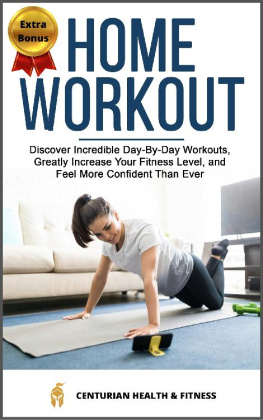Home Workout
Discover Incredible Day-By-Day Workouts, Greatly Increase Your Fitness Level, and Feel More Confident Than Ever
Centurian Health & Fitnes s
Copyright 2020 - All rights reserved.
The content contained within this book may not be reproduced, duplicated or transmitted without direct written permission from the author or the publisher.
Under no circumstances will any blame or legal responsibility be held against the publisher, or author, for any damages, reparation, or monetary loss due to the information contained within this book. Either directly or indirectly.
Legal Notice:
This book is copyright protected. This book is only for personal use. You cannot amend, distribute, sell, use, quote or paraphrase any part, or the content within this book, without the consent of the author or publisher.
Disclaimer Notice:
Please note the information contained within this document is for educational and entertainment purposes only. All effort has been executed to present accurate, up to date, and reliable, complete information. No warranties of any kind are declared or implied. Readers acknowledge that the author is not engaging in the rendering of legal, financial, medical or professional advice. The content within this book has been derived from various sources. Please consult a licensed professional before attempting any techniques outlined in this book.
By reading this document, the reader agrees that under no circumstances is the author responsible for any losses, direct or indirect, which are incurred as a result of the use of information contained within this document, including, but not limited to, errors, omissions, or inaccuracies.
Table of Contents
GET YOUR BONUS NOW
18 Days Extra HOME WORKOUT Training Plan
Download Her e
INTRODUCTION
Words such as physical activity, workout, personal preparation, preparation, health, and physical personal have sometimes been confused with each other since 1985, and are often used interchangeably.
The rapid socio-economic and demographic change, the need to take advantage of the natural dimension, has led to a diversification of the application of physical exercise/sport that it is posing itself today with different objectives and with the study of various types of contentment.
Thereby decreasing demand for organized competition, competitive racing, and increasing individualized physical activity aimed at achieving specific goals such as personal health or psychophysical wellbeing. Nevertheless, a rather complicated fact is the practice of physical workouts, or generally known as "fitness," "exercise," "conditioning," "resistance training" or better "fitness training."
Nevertheless, with the word exercise, a number of activities can be described that are carried out regularly in fitness centers (gyms) and can be categorized into resistance training activities, community fitness activities, functional fitness activities.
The practices experiencing the word Fitness emerged in the last decade. Originally aerobics, step aerobics, jogging, conditioning, and bodybuilding were the most popular gym activities that allowed the population to "get healthy," now we can find more varied and more attentive to the needs of active and non-active population activities.
Types include: funky, zumba, fit box, fitness exercises, exercise focused on calisthenics, cross-fit, balance exercise, kettlebell training, total body conditioning, core training, boot camp, functional training, pilates, yoga, stretching.
This is clear that with these practices under the more common term exercise or exercise preparation, a psychological cycle begins in people's mind where day by day, the definition of the word itself is mutating.
There are various meanings of fitness, ranging from an ability to actively perform everyday tasks to a display of characteristics and skills associated with a reduced risk of the early development of hypokinetic diseases (e.g., those related to physical inactivity). And, when we talk about fitness, we include the state of wellness that is characterized as a multidimensional state of being that describes an individual's nature of positive health as being exemplified by quality of life and a sense of wellbeing.
There is no question, in accordance with this concept, that there is a close connection between physical exercise and other components of wellness. Physical activity, however, is neither health nor wellbeing .
There is ample evidence that physical exercise can minimize the likelihood of disease and early death and the habits that make it up.
Fitness can also contribute to increased cognitive performance and improve one's ability to engage in leisure time, often a rewarding social activity. Health and wellbeing are therefore, much broader terms than physical fitness. Poor health can occur even in highly fit people due to factors beyond personal control such as genetic conditions or bacterial / viral infection conditions.
Hypokinesia is commonly correlated with a reduced level of fitness.
This is a risk factor for multiple disorders such as cardiovascular ailments, diabetes, metabolic syndrome, hypertension and hypercholesterolemia. Although inactive individuals develop an RR due to CHD which is similar to those who smoke cigarettes, have hypertension and hypercholesterolemia.
This is only one of the numerous examples demonstrating that daily exercise is an significant factor in disease prevention, most often linked with death in developed countries. Analyzing different demographics ranging from youth to the elderly, from health to chronic disorders, from personal to casual exercise users, we will seek to address some questions like what health benefits fitness training has? Or what part does he play in preventing it? And witches have significant consequences for fitness? And more importantly, what is fitness training?
Thanks for choosing this book, make sure to leave a short review on Amazon if you enjoy it. Id love to hear your thoughts.
CHILDREN AND ADOLESCENTS FITNESS LEVELS
The American Physical Therapy Association SoP has developed a task force to summarize fitness guidelines for children and adolescents.
These state that to promote overall fitness, youth should participate in 60 minutes or more of physical activity every day, and that physical therapists should apply research relevant to health-related physical fitness when treating youth, promoting fitness, health, and wellness. A high fitness level, in this specific case, cardiovascular fitness, can improve quality of life and make ordinary tasks such as street crossing easier.
A number of 13 highly fit children and 13 low fit children aged 8- to 10-yr-old were tested on a treadmill that was integrated with an immersive virtual world. Child pedestrians crossed the street while undistracted, listening to music, or conversing on a hands-free cellular phone. Cell phones impaired street crossing success rates compared with the undistracted or music conditions for all participants, a result that supports previous research.
However, individual differences in aerobic fitness influenced these patterns. Higher-fit children maintained street crossing success rates across all three conditions, whereas lower-fit children showed decreased success rates when on the phone, relative to the undistracted and music conditions .









